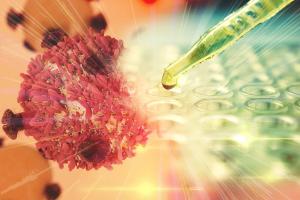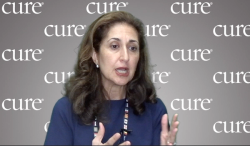The 'Flipside' of Tumor Lysis Syndrome Shows Efficacy in Leukemia, Lymphoma
Although tumor lysis syndrome may be dangerous and fatal if not treated early, experts note that it is a sign of successful treatment in patients with leukemia and lymphoma.
Cancer treatment almost always comes with side effects, regardless of how the disease is treated; chemotherapy, radiation therapy and immunotherapy all have their drawbacks.
Chemotherapy may cause hair loss, nausea and fatigue, whereas immunotherapy can cause lowered blood cell counts. But one significant side effect often occurs, paradoxically, as a result of successful treatment.
Tumor lysis syndrome is a dangerous oncological emergency that occurs when rapidly dying tumor cells release toxins into the bloodstream. This often happens as a response to effective treatment, but it can also happen spontaneously. The phenomenon tends to be more common in patients with a diagnosis of lymphoma or leukemia compared with other types of cancer. It can cause organ damage, and even be fatal. However, experts say that tumor lysis syndrome is well understood and can usually be effectively treated and prevented.
What is Tumor Lysis Syndrome?
“Tumor lysis syndrome is when a patient with cancer is receiving a therapy, such as chemotherapy or other drugs, and the treatment is working so well that it’s actually breaking the tumor cells open too quickly,” explained Dr. Matthew S. Davids, associate professor of medicine at Harvard Medical School and director of clinical research in the division of lymphoma at Dana-Farber Cancer Institute in Boston, in an interview with CURE®. “And the tumor cells have toxins inside them. They have different types of salts, like electrolytes, and when those toxins and salts get spilled into the blood too quickly it overwhelms the body’s ability to clear them out.”
These electrolytes, particularly potassium and phosphate, would normally be handled by the kidneys and eliminated from the body in a patient’s urine. But, when the levels of these waste products become too great for the kidneys to handle, they can cause organ damage.
“The kidneys can’t clear out the toxins, and that can lead to serious issues for patients,” Davids continued. “This can include things like kidney issues or even heart issues. In its most serious forms, tumor lysis syndrome can even be life-threatening or fatal, but it also has milder forms where we only see these lab changes, and we can address them, and patients can still do very well.”
Notably, patients with lymphoma and leukemia are at particular risk because these blood cancers can be particularly sensitive to certain treatments and often come with a high tumor burden, meaning there are large numbers of tumor cells in a person’s body.
One study of patients with chronic lymphocytic leukemia who were treated with the drug Venclexta (venetoclax) found that 2.7% of patients developed clinical tumor lysis syndrome, meaning these patients showed both high levels of toxins in a blood test and clinical complications, while 5.7% of patients had tumor lysis syndrome as determined by lab work.
Another study of patients with acute myeloid leukemia treated with Venclexta and either Vidaza (azacitidine) or Dacogen (decitabine) found that 18% of patients developed tumor lysis syndrome according to their bloodwork; 5% of patients developed clinical tumor lysis syndrome.
In general, research states that 3% to 7% of patients with leukemia and 4% to 11% of patients with lymphoma develop tumor lysis syndrome, though some subtypes of these cancers may have an incidence as high as 25%.
Signs, Symptoms and Diagnosis
The symptoms of tumor lysis syndrome are vague and nonspecific, meaning patients are unlikely to identify it themselves, or know which signs to look out for. People with tumor lysis syndrome show symptoms like fatigue or malaise, nausea and vomiting, or sometimes flank pain (pain in one side of the body between the upper stomach area and the back), but these symptoms apply to many situations and will not immediately make a patient think of tumor lysis syndrome.
“There’s really not too much that patients will notice,” Davids noted. “At least not in the early stages.”
The only way to detect tumor lysis syndrome in its early stages is through blood testing. Usually, a patient’s care team will be aware of the risk and will conduct lab testing accordingly. When care providers know a patient is at risk for developing tumor lysis syndrome, they can take steps to prevent it with medicine and make sure the patient is properly hydrated to ensure good kidney function. Once it is diagnosed, clinicians must move quickly to treat it.
“There are really two scenarios in tumor lysis syndrome. There are the outpatients, and that’s who I see,” said Amy Goodrich, a nurse practitioner in the Hematologic Malignancies Program and research nursing manager at The Johns Hopkins Kimmel Cancer Center in Baltimore, in an interview with CURE®. “We do a very good job of preventing tumor lysis syndrome because we have time. We have time to get the medications they need and make sure they’re hydrating and getting them set up to avoid (it).”
But not all patients have the luxury of preparing in advance. When care teams have to administer cancer treatment as soon as possible, a different approach is necessary. These patients are often people with acute leukemias or aggressive lymphomas.
“Then there are inpatients,” Goodrich continued. “In the inpatient setting, those are the super-sick people, the urgent patients, who you don’t have time to get them all those preparations.”
Two main drugs are used to prevent and/or treat tumor lysis syndrome, Goodrich highlighted. Allopurinol is an oral drug that is used as a preventive measure to stop the body from producing uric acid, thereby avoiding buildup of this toxin in the patient’s body. Clinicians will start a patient on allopurinol in the days leading up to chemotherapy and will try to make sure the patient is drinking at least 64 ounces of fluid each day.
Elitek (rasburicase), a drug usually administered intravenously, can rapidly lower a patient’s levels of uric acid, making it a good emergency measure. And there are other drugs that can be used to control a patient’s potassium and phosphate levels. Goodrich added that patients are most likely to experience tumor lysis syndrome during their first cycle of therapy, because this is when their tumor burdens are the greatest.
“By the next time they get treated, their tumor burden is really low and that risk of overwhelming the kidneys is significantly lower,” Goodrich explained.
Emergency Treatment
In some situations, patients may need dialysis to clear the toxins from their blood.
“A nephrologist like me will have to come in and essentially clean up the blood, because with the death of those tumor cells, which is a wanted outcome, we are now dealing with the debris, which the kidney cannot take care of,” said Dr. Khalid Bashir, a nephrologist and associate professor of medicine at Creighton University in Omaha, Nebraska. “(We have to) clean out the extra phosphate, clean out the extra potassium, normalize the calcium.”
He added that generally, preparation and prevention is enough to avoid emergency situations.
“For the most part we don’t have to dialyze them. If we’re called in a timely fashion, this is a very preventable thing. These patients may not go into tumor lysis syndrome,” Bashir continued. “But even if they go into tumor lysis syndrome, despite our interventions with intravenous fluids or medications, if it has overwhelmed patients’ ability to get rid of these waste products, then we have to bring in a machine … and clean out the blood.”
The situation can become dire in a short time, experts say — as little as a matter of hours — but intervention can be handled quickly as well.
“Dialysis is needed, and usually is done, in a very quick fashion,” Bashir added.
What Patients Should Know
Goodrich said patients who are at risk of developing tumor lysis syndrome are generally not adequately informed, but this is not the fault of any person. Rather, she continued, patients may not remember discussing the possibility of tumor lysis syndrome because they are preoccupied with receiving treatment for a deadly disease. Furthermore, getting patients to adhere to preventive measures can be difficult.
“It’s only preventive if they’re taking their allopurinol and hydrating at home,” she said. “It is continuously amazing to me how many people have a cup of coffee in the morning and a little water at dinnertime and that’s all they drink all day. Those folks, it’s a real challenge to get them to hydrate.”
If patients show low-level laboratory tumor lysis syndrome on blood tests but don’t exhibit changes in their kidney or heart function, Goodrich said, they can expect to receive extra fluids and medications in an outpatient setting. If clinicians notice abnormal heart or kidney function, however, the patient will be admitted to the hospital.
Davids says he advises patients about the possibility of tumor lysis syndrome, but only in situations where it is likely to happen.
“I only tell patients about it if I think it’s a significant risk to an individual,” he said.
Davids also emphasized that tumor lysis syndrome is a byproduct of successful treatment.
“Although tumor lysis syndrome seems very scary, which it can be, the flipside of it is that it suggests the cancer therapy is working extremely well,” he concluded. “Having a little bit of tumor lysis syndrome, as long as it’s very closely monitored and managed, may not be such a bad thing. This is something we’re trained as oncologists to manage.”
For more news on cancer updates, research and education, don’t forget to subscribe to CURE®’s newsletters here.
Related Content
 When Others say Your Own Thoughts About Cancer Aloud
When Others say Your Own Thoughts About Cancer AloudMay 21st 2025
 Expert Explains Lymphoma After Dave Coulier's Diagnosis
Expert Explains Lymphoma After Dave Coulier's DiagnosisDecember 4th 2024
 Breyzani Benefits Previously Treated SLL, CLL
Breyzani Benefits Previously Treated SLL, CLLJuly 12th 2023
 What Is CAR-T Cell Therapy, and What Can Patients With Cancer Expect?
What Is CAR-T Cell Therapy, and What Can Patients With Cancer Expect?September 16th 2022
 New Treatments Lend a Positive Outlook to Patients With GVHD
New Treatments Lend a Positive Outlook to Patients With GVHDFebruary 28th 2022
View additional resources on CureToday.com





